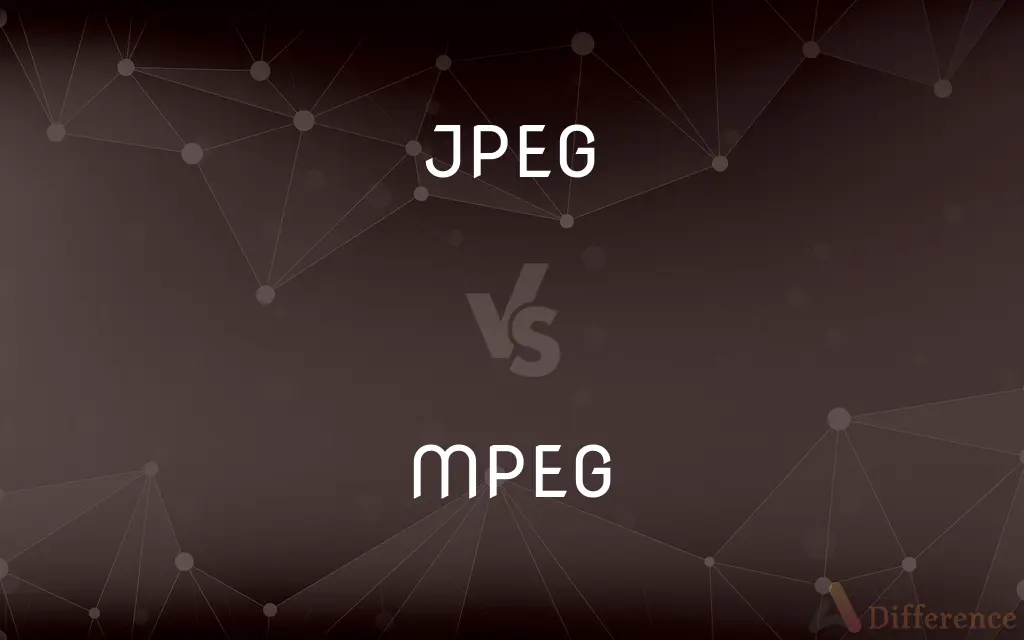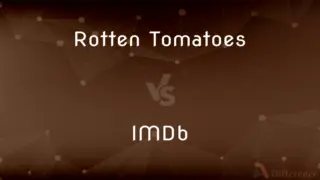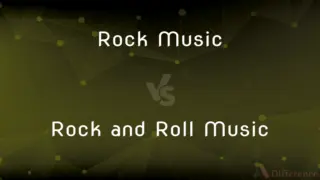JPEG vs. MPEG — What's the Difference?
By Tayyaba Rehman & Urooj Arif — Published on February 9, 2024
JPEG is a commonly used format for compressing images, while MPEG is a standard for compressing audio and video files, allowing for efficient storage and transmission.

Difference Between JPEG and MPEG
Table of Contents
ADVERTISEMENT
Key Differences
JPEG (Joint Photographic Experts Group) is primarily used for compressing and storing digital images. Its compression algorithm reduces file size significantly while maintaining reasonable image quality, making it ideal for sharing photos online. In contrast, MPEG (Moving Picture Experts Group) refers to a set of standards used for compressing audio and video files. MPEG compression enables the efficient transmission of multimedia over bandwidth-limited networks, ensuring that movies and music are easily streamed and downloaded.
While JPEG is renowned for its lossy compression, which subtly reduces image quality to decrease file size, it remains the preferred format for still images due to its balance between quality and file size. MPEG, however, deals with both audio and visual data and is essential in the world of digital television and DVD production. Its compression technique is more complex, as it must handle the synchronization and compression of multiple frames and sound.
JPEG files are static, representing single images, and are widely used in digital photography and web graphics. Their ability to be easily opened, edited, and shared makes them highly popular. Conversely, MPEG files are dynamic and can store complex multimedia content, including movies and music videos, where both sound and image are important. MPEG's ability to compress this content into small files makes digital broadcasting and online streaming feasible.
JPEG’s compression algorithm is specifically tailored for photographs and images, where subtle nuances of color and light are more important than the precise arrangement of every pixel. On the other hand, MPEG focuses on the temporal and spatial compression of multimedia content, reducing file size by removing redundant and non-essential data that human eyes and ears are unlikely to detect.
In summary, while JPEG is indispensable for photographers and web designers due to its efficiency in storing high-quality images in small file sizes, MPEG is crucial for multimedia applications, allowing for the streaming and broadcasting of audiovisual content without consuming excessive bandwidth or storage space.
ADVERTISEMENT
Comparison Chart
Primary Use
Compressing and storing digital images
Compressing audio and video for streaming and broadcasting
Compression Type
Lossy, mainly for static images
Lossy, for audio and video sequences
File Extension
.jpeg or .jpg
.mpeg or .mpg
Complexity
Relatively simple, designed for images
More complex, designed for synchronized audio and video
Usage Scenario
Digital photography, web graphics
Digital TV, online streaming, DVDs
Compare with Definitions
JPEG
JPEG is a widely used image format known for its efficient compression.
The photographer saved the photo as a JPEG to reduce the file size.
MPEG
MPEG files can contain both moving images and synchronized audio.
The MPEG file contained the entire music video, including sound and high-definition visuals.
JPEG
It's a standard format supported by almost all image viewing and editing software.
The digital camera saves all its pictures in the JPEG format by default.
MPEG
MPEG is a set of standards for compressing audio and video files.
The movie was encoded in MPEG format to ensure it was compatible with various players.
JPEG
JPEG is suitable for storing and sharing digital photographs.
He converted the image to JPEG before emailing it to his client.
MPEG
It's widely used in broadcasting, DVD production, and online streaming.
The broadcaster adopted the latest MPEG standard to improve the clarity and stability of the transmission.
JPEG
JPEG allows adjustable compression levels to balance image quality and file size.
She adjusted the JPEG compression level to keep the image quality high for printing.
MPEG
It enables efficient digital storage and transmission of multimedia.
The streaming service uses MPEG compression to deliver high-quality video with minimal buffering.
JPEG
It uses lossy compression to decrease file size with minimal quality loss.
The website used JPEG images to ensure pages loaded quickly.
MPEG
MPEG compression reduces file size by removing redundant information.
The editor used MPEG's advanced compression to fit the entire film onto a single DVD.
JPEG
A standard algorithm for the compression of digital images.
MPEG
Any of a set of standards established for the compression of digital video and audio data.
JPEG
A digital image stored as a file so compressed
A JPEG of a cat.
MPEG
A file of digital video and audio data that has been so compressed
Downloaded an MPEG of the new video from the internet.
JPEG
Alternative case form of JPEG
JPEG
A standardized format for storing graphic data in binary computer files, allowing over 16 million different colors. It allows for lossy compression, i. e. the compression of data into a form which re-expands into an image close, but not identical to the original image. Files stored in this format usually carry the extension jpg or jpeg. Compare GIF.
Common Curiosities
What is the main advantage of JPEG for images?
JPEG significantly reduces file size while maintaining acceptable image quality, ideal for storage and sharing.
Is MPEG suitable for high-definition video?
Yes, certain MPEG standards are specifically designed to handle high-definition video efficiently.
How does JPEG compression affect image quality?
JPEG compression can reduce image quality, especially at higher compression levels, leading to artifacts like blurring or pixelation.
Can MPEG be used for audio files only?
Yes, MPEG includes standards like MP3 for audio-only compression as well as standards for audiovisual content.
Do JPEG images support animation?
No, JPEG is for static images. Animated formats include GIF and MPEG for video.
Can the quality level of JPEG compression be adjusted?
Yes, users can adjust the level of compression to balance image quality and file size.
What's the difference between MPEG-2 and MPEG-4?
MPEG-2 is used for digital TV and DVDs, focusing on broadcast quality, while MPEG-4 supports lower data rates and is used for online video and streaming.
Why is JPEG popular in digital photography?
JPEG is popular due to its balance between image quality and file size, making it practical for storage and sharing.
Is JPEG lossless or lossy compression?
JPEG uses lossy compression, meaning some original image data is lost.
Are MPEG files larger than JPEG files?
Generally, yes, because MPEG files contain more complex data, including audio and sequences of images.
How does MPEG handle audio and video synchronization?
MPEG uses specific algorithms to ensure audio and video tracks play in sync, providing a seamless viewing experience.
Can JPEG handle transparency?
No, JPEG does not support transparency. Formats like PNG are better suited for that.
What is the impact of MPEG compression on video quality?
MPEG compression can lead to a loss in video quality, especially at higher compression ratios, but it's generally optimized to preserve as much quality as possible.
Do all media players support MPEG files?
Most modern media players support MPEG files, but compatibility depends on the specific MPEG standard and the player.
What is a common use case for MPEG files?
MPEG files are commonly used for movies, online video streaming, and digital television.
Share Your Discovery

Previous Comparison
Rotten Tomatoes vs. IMDb
Next Comparison
Rock Music vs. Rock and Roll MusicAuthor Spotlight
Written by
Tayyaba RehmanTayyaba Rehman is a distinguished writer, currently serving as a primary contributor to askdifference.com. As a researcher in semantics and etymology, Tayyaba's passion for the complexity of languages and their distinctions has found a perfect home on the platform. Tayyaba delves into the intricacies of language, distinguishing between commonly confused words and phrases, thereby providing clarity for readers worldwide.
Co-written by
Urooj ArifUrooj is a skilled content writer at Ask Difference, known for her exceptional ability to simplify complex topics into engaging and informative content. With a passion for research and a flair for clear, concise writing, she consistently delivers articles that resonate with our diverse audience.
















































